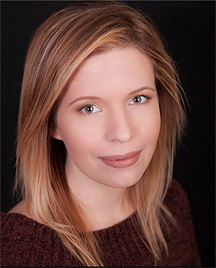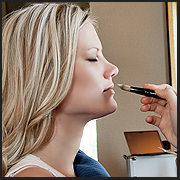Makeup artist Natalie Hayes joins us to talk about her work in the film, TV and corporate arenas.
Communication is Critical
Key for Hayes on any project is communication. “I find that, too often, there is no (prior) communication about lighting.” It’s all about doing good work while being efficient. “It is much easier,” she says, “to make adjustments to the makeup on the front end versus reacting to it later when seeing the talent on camera (and then everyone is waiting on you).”
Hayes says, “Ideally I would be communicated with before applying makeup about what lighting conditions would be, and then I’d be given first glances at the talent through the monitor as soon as they are in the environment so that I could tweak anything necessary before filming began.”

Natalie Hayes
Her reality is often different. “What I usually find is that I’m tied up still doing makeup apps on additional talents/extras when initial shooting begins on talent I’ve already done makeup on. By the time I’m on set and looking through the monitor, I may see some things that could’ve been tweaked. For example, the cheek color isn’t showing up under this lighting, and so the talent looks a little pasty.” The magic word is continuity. “That can be a little frustrating because for continuity’s sake, I can’t change someone’s look after shooting has started. Yet I know they could’ve looked even better had I gotten to view them and tweak if needed when they first stepped under the lighting.”
Makeup in the Commercial/Corporate Genre
Much of Hayes’s makeup experience has been in corporate and commercial arenas. “Corporate/commercial makeup is all about creating a look that says ‘conservative, clean attractiveness.’ No matter how much makeup you are actually using, the end result should look like you have not used very much.
“On the men, I’m basically evening out skin tone, taking down any discoloration and shine, adding just a tad of cheek color and sculpting, minimizing any blemishes, and taming the brows. It’s a finely-tuned version of who they already are.
“On the women,” says Hayes, “it’s about flawlessness, conservative matte eye shadows, conservative lip colors, that sort of thing (the most attractive conservative ‘everyday’ look).”
Makeup Possibilities in Film
“Then when it comes to film,” says Hayes, “the world of possibilities… opens up and my limits are pleasantly pushed. For example, one day I can be making a female character look very tired, unattractive, and disheveled if her character did not sleep the night before in the story. Then the next time I’m making her up, she could be going to a formal event for a scene and need a glamorous and dramatic/bold smoky eye look with gorgeous red lips and beautiful, long lashes.
“So the predictability factor leaves when film makeup enters the picture, and you get to really step inside the world of each character and think, ‘ok, what would this person probably look like in this scenario. Do they normally spend time on their appearance, or would they be disinterested, for example’. The imagination is really exercised in a fun way for film, whereas it’s very conservative for the average TV commercial or industrial video/web shoot.”
Keeping Current
“I love, love, love to be educated by anyone skilled in the world of makeup artistry, so anytime there is a makeup seminar or class offered in Atlanta, you can bet I will attend. I also study the work of other makeup artists, read books, ask questions, and am a member of a makeup artist’s organization here in Atlanta. Additionally, I research trends/tips online.”
“When it comes to hair, I’m admittedly less focused/interested, as my craft is makeup artistry. In an ideal world, I would be able to do only makeup for every job, and a hair stylist would handle hair. But it’s not always that way, so when I know there’s a hair component to an upcoming job I will do what is needed to be sure I can create the requested look. This usually involves some level of internal panic as, like most makeup artists, I really wasn’t born with a knack for styling hair. Or a profound desire to do so.”
Research
Hayes says she’ll do all the research needed to create the right look for a project. “I must feel comfortable that I can deliver what’s requested. I would never want to let the director or the production down. I enjoy the research process because it involves imagination as well (what would someone in this era and/or in this particular scenario probably look like?)”
Color Theory in Makeup

Hayes at work
For Hayes, color theory is critical to the process of evening out skin tone. “Colors that are opposite each other on the color wheel cancel each other out. So, say I’m doing makeup on a man who shows up with really red cheeks and nose. I will apply green color corrector to his red areas to neutralize the green, before applying any concealer or foundation.
“Or if someone has purple/blue discoloration under the eyes, I’ll use an orange-ish color corrector to prime that area. Color correcting can be a lifesaver. For example, one time during a commercial shoot, the talent got nervous and a red blotch formed on her neck. Instead of spending time matching foundations, priming the skin, applying the foundation or concealer, I simply took green color corrector and was able to cancel out enough of the red instantly. The director did not see what I did to produce the result but said, ‘Wow, you fixed that super fast! Thanks!’”
Makeup Tips for Young Filmmakers
Hayes offers a few basic makeup tips for young filmmakers: “quickly take shine down (I recommend Peter Thomas Roth’s mattifier), quickly color correct (the Smashbox or Make Up For Ever color correctors are great), tame fly-aways (Goldwell’s Mellogoo pomade) or make frazzled ends of hair look healthy (Biosilk). These simple steps can greatly help the overall looks of the talent.”
See Natalie Hayes’s website.
